Succulent beef and crispy vegetables seasoned with generous amounts of spices, Sichuan boiled beef is super flavoursome!
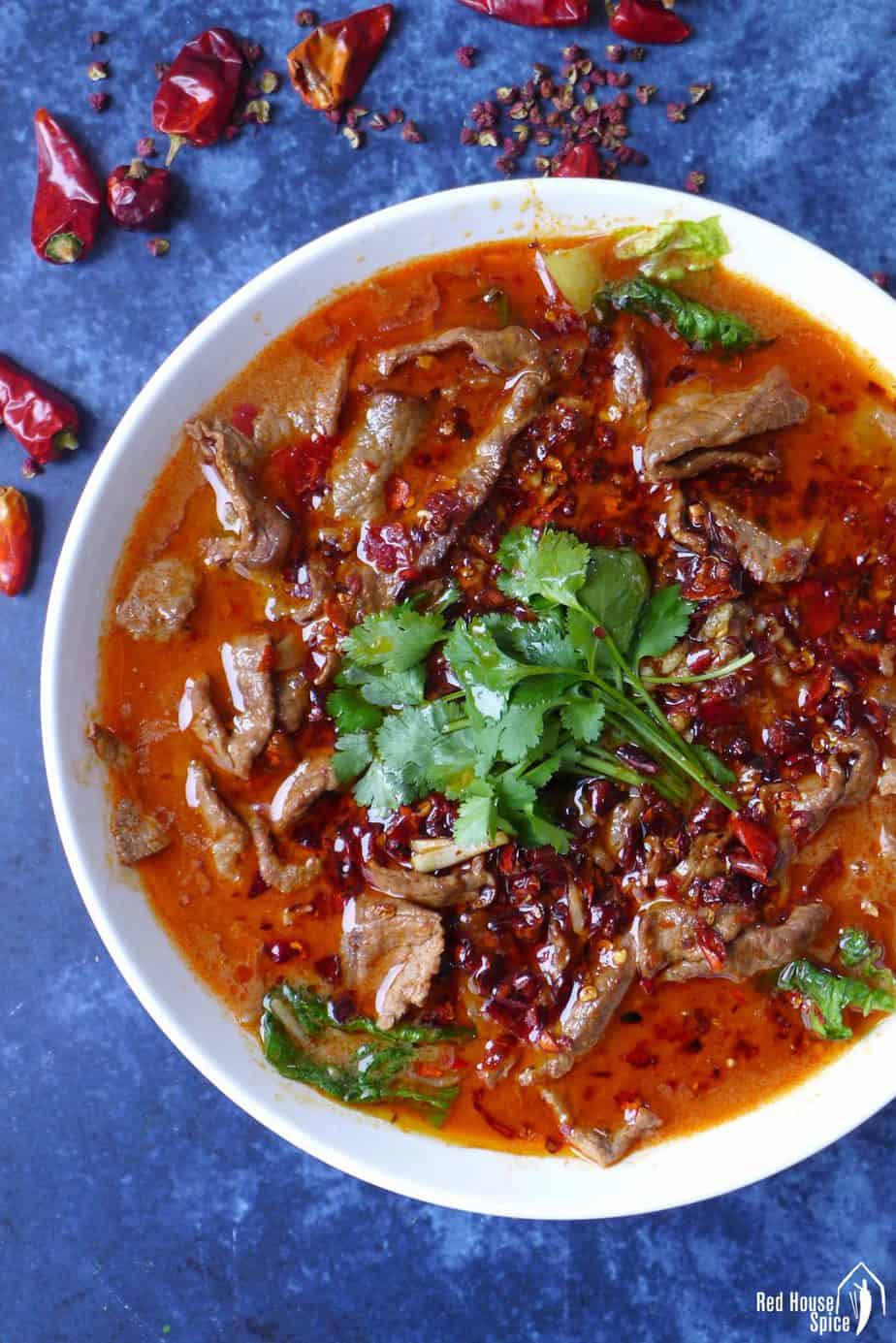
Jump to:
What is Sichuan boiled beef
If you are a regular reader of my blog, you must have noticed my passion for Sichuan cuisine. Today’s recipe Sichuan boiled beef (Shui Zhu Niu Rou/水煮牛肉) is another classic dish on my Sichuan list. It’s truly irresistible so you must give it a try!
The Chinese name for this dish is “Shui Zhu Niu Rou/水煮牛肉”, literally meaning water boiled beef. Sounds plain and mild, right? In fact, it’s super pungent and exciting. It’s a sister dish of Sichuan Boiled Fish which is one of the most popular recipes on my blog.
Succulent beef slices and crispy vegetables are seasoned with generous amounts of dried chilli, Sichuan peppercorn, chilli bean paste, ginger, garlic, etc. Hot, numbing and aromatic, it creates a mini party on your tastebuds!
Six cooking steps
Let’s firstly talk about the workflow of cooking Sichuan boiled beef. The following six steps outline the methods and sequence required:
- Marinate the beef: Combine beef slices with rice wine, soy sauce, egg, cornstarch and water. Coat with a thin layer of sesame oil.
- Fry the spicy topping: Fry dried chillies and Sichuan peppercorns with a little oil then chop small.
- Fry the vegetables: Fry crispy vegetables until they lightly wilt.
- Prepare the broth: Fry ginger, garlic, Sichuan chilli bean paste and chilli powder until fragrant. Then pour in stock/water.
- Cook the beef: Add marinated beef piece by piece. Simmer until fully cooked. Add to the vegetables.
- Sizzle & garnish: Place garlic & chopped spicy topping over the beef. Pour hot oil over. Garnish with coriander.
Please refer to my tutorial video (in the recipe card below) to see how I cook it.
How to make the beef succulent
The most important part of cooking Sichuan boiled beef is to make sure the beef is tender and succulent. Tough, chewy beef would ruin the enjoyment of the dish even if you’ve got the flavour right. Here are four tips to help you succeed:
1. Choose the right cut of beef
Different cuts of beef have quite different textures. Based on the availability and your budget, choosing the right cut of beef is the first decision you need to make. Tendre cuts with a little fat are preferable.
To be honest, I don’t have much in-depth knowledge of beef cuts (still learning every day). But I found some good online resources on this matter. “The Complete Guide to Beef Cuts” explains the standard cuts in the UK, whereas “Learn Where the Cuts of Beef Come From” shows a list of American primal cuts.
I use “Thick Rib” bought from British mainstream supermarket (I believe it’s the equivalent of Cross-Rib Chunk in the US). It’s an inexpensive cut, yet very flavourful and tender enough for this dish when marinated properly.
2. Slice the beef the right way
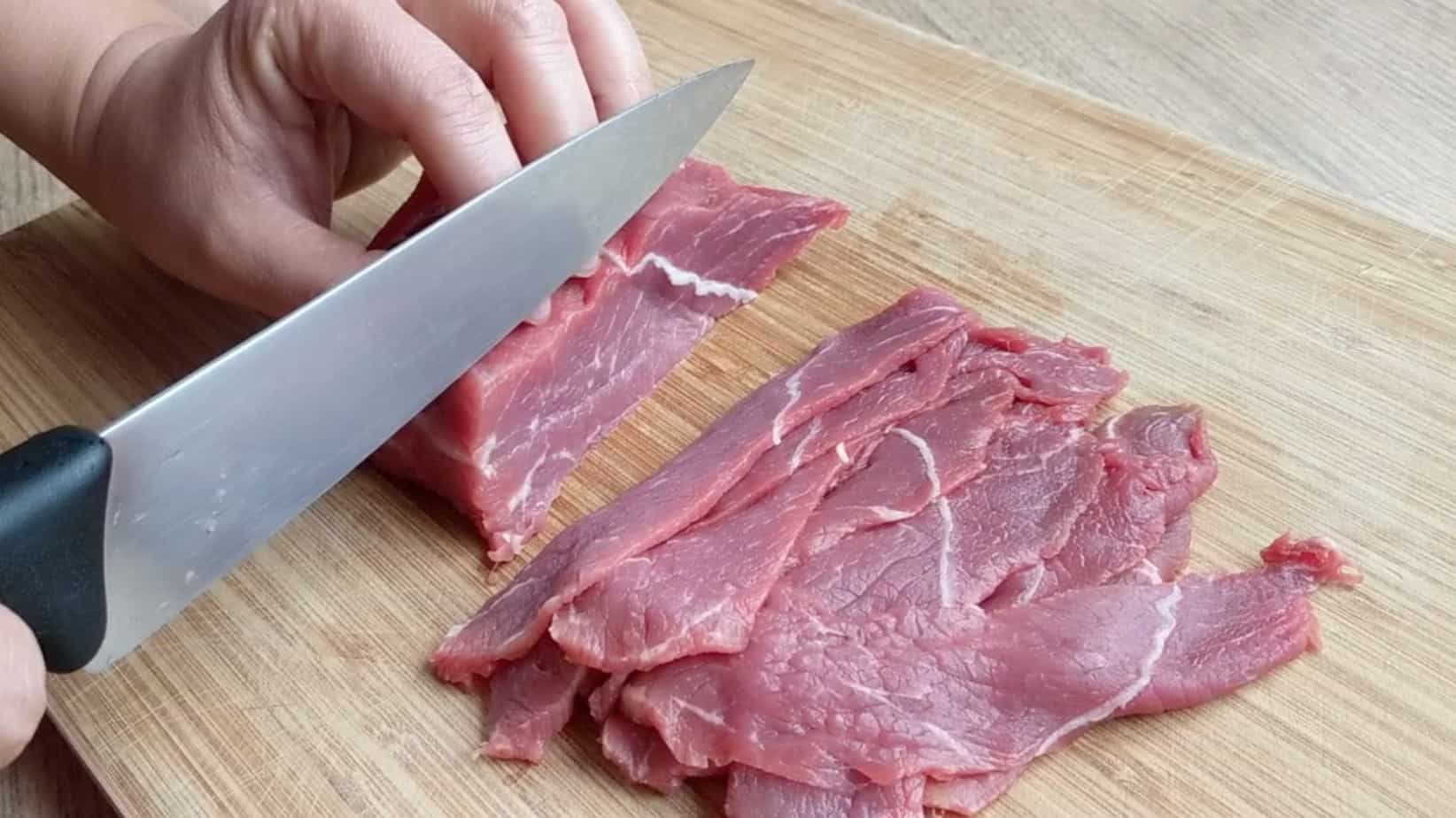
For Sichuan boiled beef, you need to cut the beef into thin slices, ideally around 2mm in thickness.
- Sharpen your knife first. This helps a lot.
- Make sure you slice the meat against the grain for the best tenderness.
- If you find it difficult to slice fresh beef, put it into the freezer until half frozen then cut.
3. Marinate to lock in the moisture
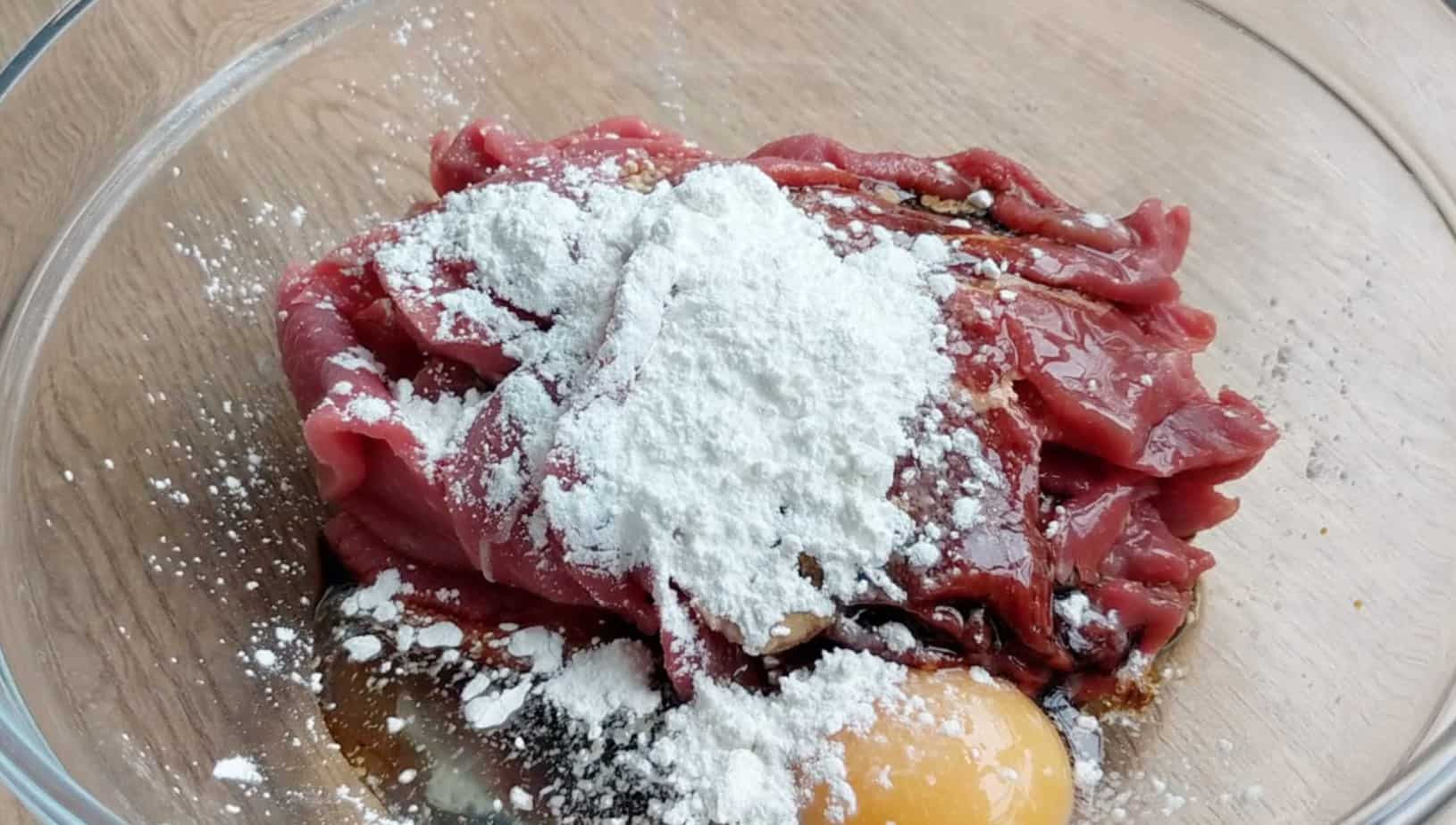
To marinate the beef slices, you would need to:
- Mix beef with salt, Shaoxing rice wine, dark soy sauce (or regular soy sauce), egg, cornstarch and water.
- Rub and stir with hand until all the liquid is absorbed.
- Drizzle a little sesame oil to separate the beef slices and to add extra flavour.
4. Cook it for the correct time
As the name “Sichuan boiled beef” suggests, the beef slices are cooked in the broth instead of stir-frying. To avoid overcooking the beef thus making it tougher, you should:
- Turn down the heat when you start putting the beef into the broth.
- Add beef piece by piece to avoid sticking.
- Simmer the beef, instead of violently boiling.
- Remove from the heat as soon as no pinkness can’t be seen on the surfaces of the meat.
Make a delicious broth
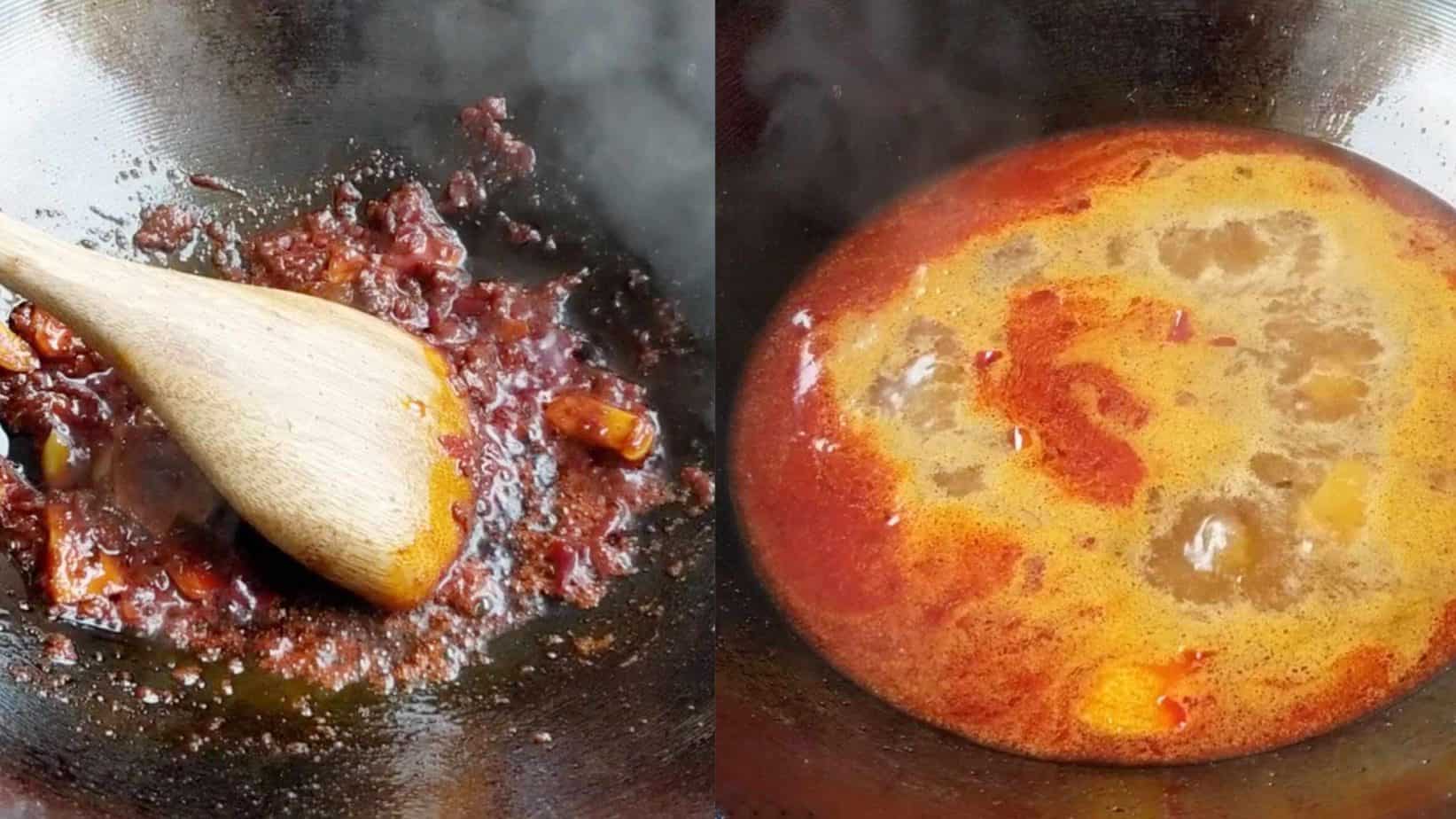
To make a delicious broth in which the beef slices are cooked, you will need:
- Cooking oil to fry the seasoning
- Sichuan chilli bean paste & chilli powder to spice up the broth
- Sliced ginger & garlic to add flavour
- Unsalted stock or water
Sichuan chilli bean paste (Doubanjiang/豆瓣酱), aka broad bean paste, is the key ingredients for the tasty broth. It’s widely used in Sichuan cuisine and can be purchased in Chinese stores/online shopping platforms. The best-known variety is Pixian Douban (郫县豆瓣, Pixian broad bean paste) which needs to be coarsely chopped prior to cooking.
Choose crispy vegetables
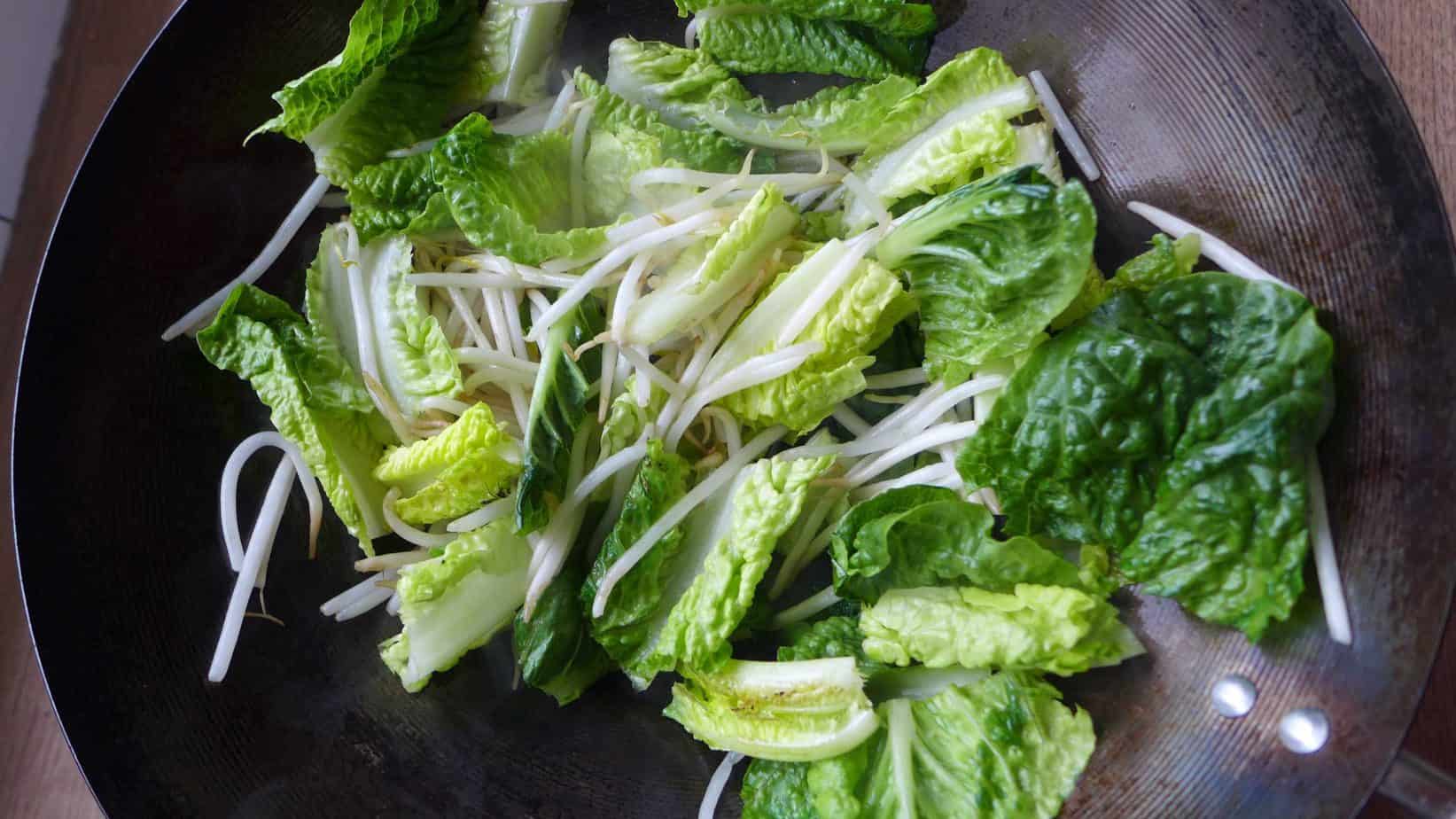
Sichuan boiled beef is not purely a meat dish. Underneath the beef, you always find some crispy vegetable. Bean sprouts (either mung bean sprouts or soybean sprouts), celery, lettuce, and Chinese cabbage are the popular choices. I use the combination of bean sprouts and romaine lettuce for this recipe. Please feel free to make your own choice.
Use good quality spices
What makes Sichuan boiled beef super addictive is the wonderful Málà (hot & numbing) sensation created by dried chillies and Sichuan peppercorns. Using those two spices with the best quality possible will make your dish stand out.
Mix different types of chillies
Good chillies should not only be hot but also aromatic. You may choose the variety that suits your level of tolerance to spiciness. Overly hot chillies tend to kill other flavours thus are not recommended.
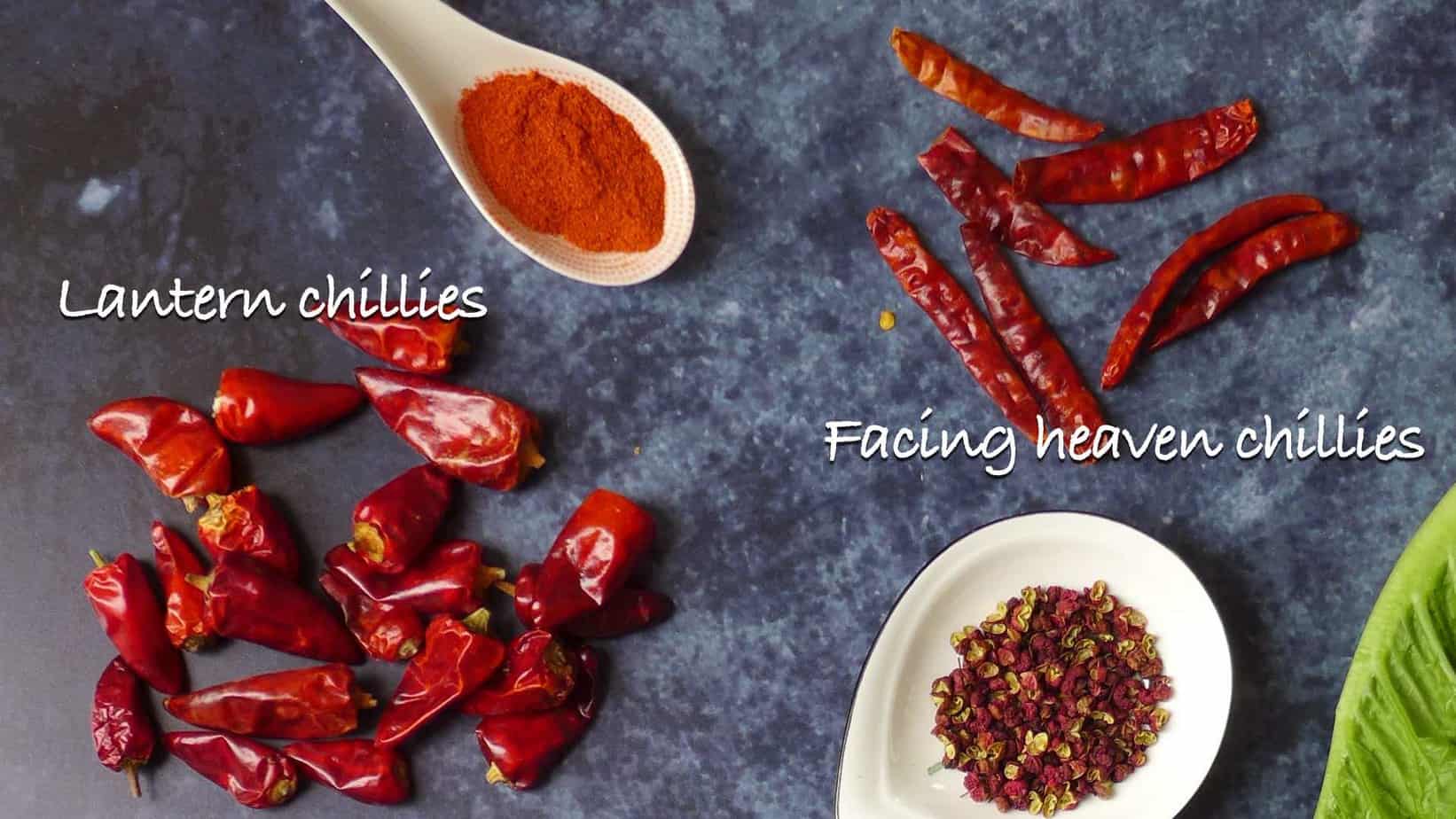
I mix two types of Chinese dried chillies to create a Xiāng Là (香辣, hot & fragrant) taste for this dish:
- Facing heaven chilli (Chao Tian Jiao/朝天椒). It’s a variety of chilli commonly used in Sichuan cuisine. It’s about 4-6 cm long and has a quite high heat level.
- Lantern chilli (Deng Long Jiao/灯笼椒). It’s named after its lantern-like shape and is mild in heat but very fragrant.
The quality of Sichuan pepper matters
The numbing sensation and citrus aroma delivered by Sichuan pepper is critical too. As my post “Sichuan pepper: your questions answered” explains, there isn’t any substitute for this unique spice. Good quality Sichuan peppercorns will add a lot of excitement to the dish.
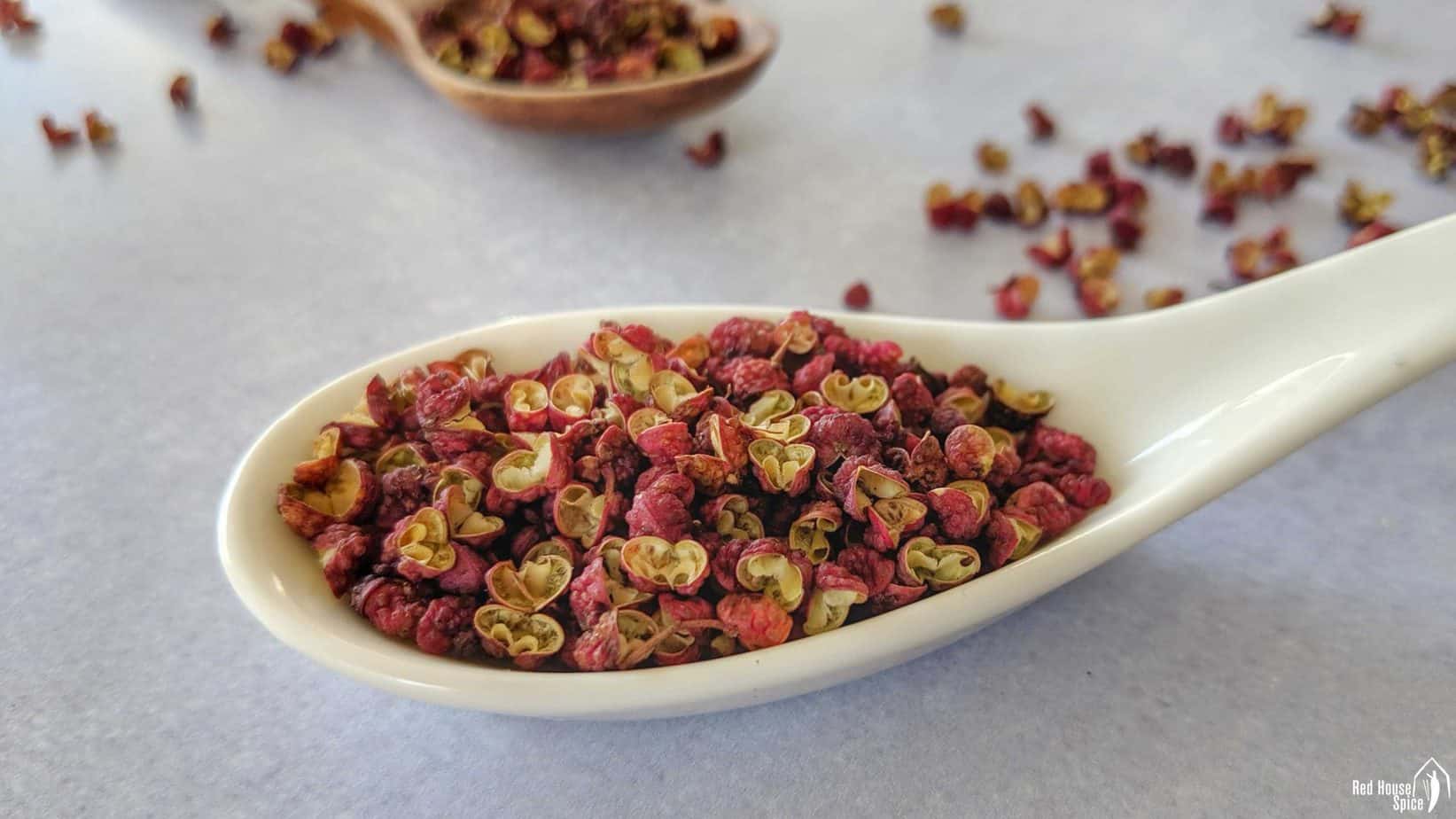
When buying, you need to look out for the following traits:
- Look: They are even in size and bright in colour. Husks open with very few black seeds left inside.
- Smell: They have a powerful, enticing aroma. Rub a few peppercorns then smell your fingertips. The smell should be very noticeable.
- Taste: Chew one peppercorn. The tingling, numbing sensation should be strong and linger for several minutes in your mouth. No strange bitterness though.
Also, please feel free to use either regular red Sichuan peppercorns or the green variety. Or, use the mixture of both.
Two steps to bring out their best flavour
Heat brings out the best aroma and flavour of chilli and Sichuan pepper. Follow two steps to achieve this:
1. Fry dried chillies and Sichuan peppercorns in a little oil over low heat until fragrant. Watch attentively to make sure you don’t burn them.
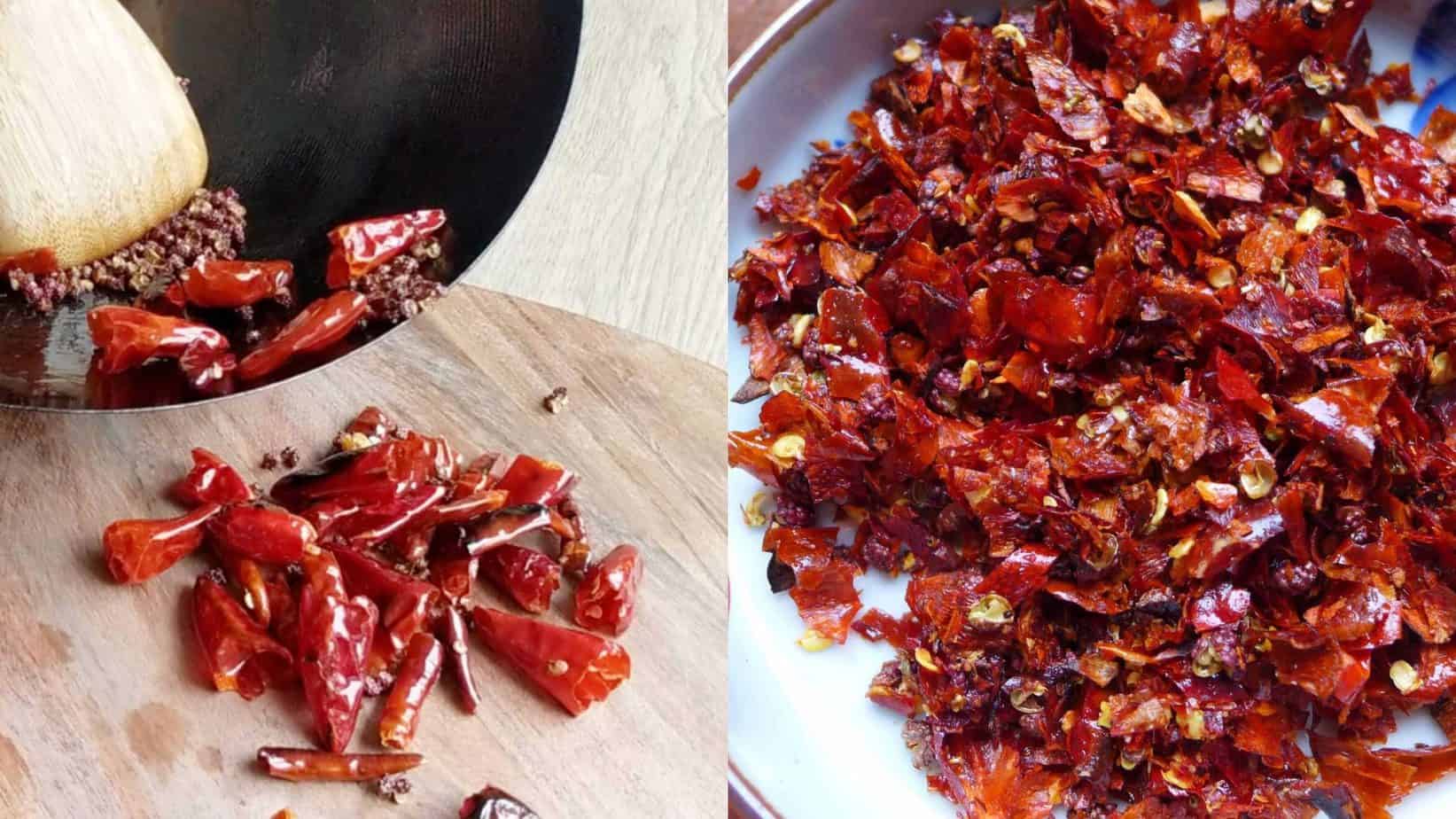
2. Chop the spices small then place onto the cooked beef. Pour hot oil over to sizzle. This last procedure really enhances the “Málà” taste of the dish. Serve it hot with steamed rice.
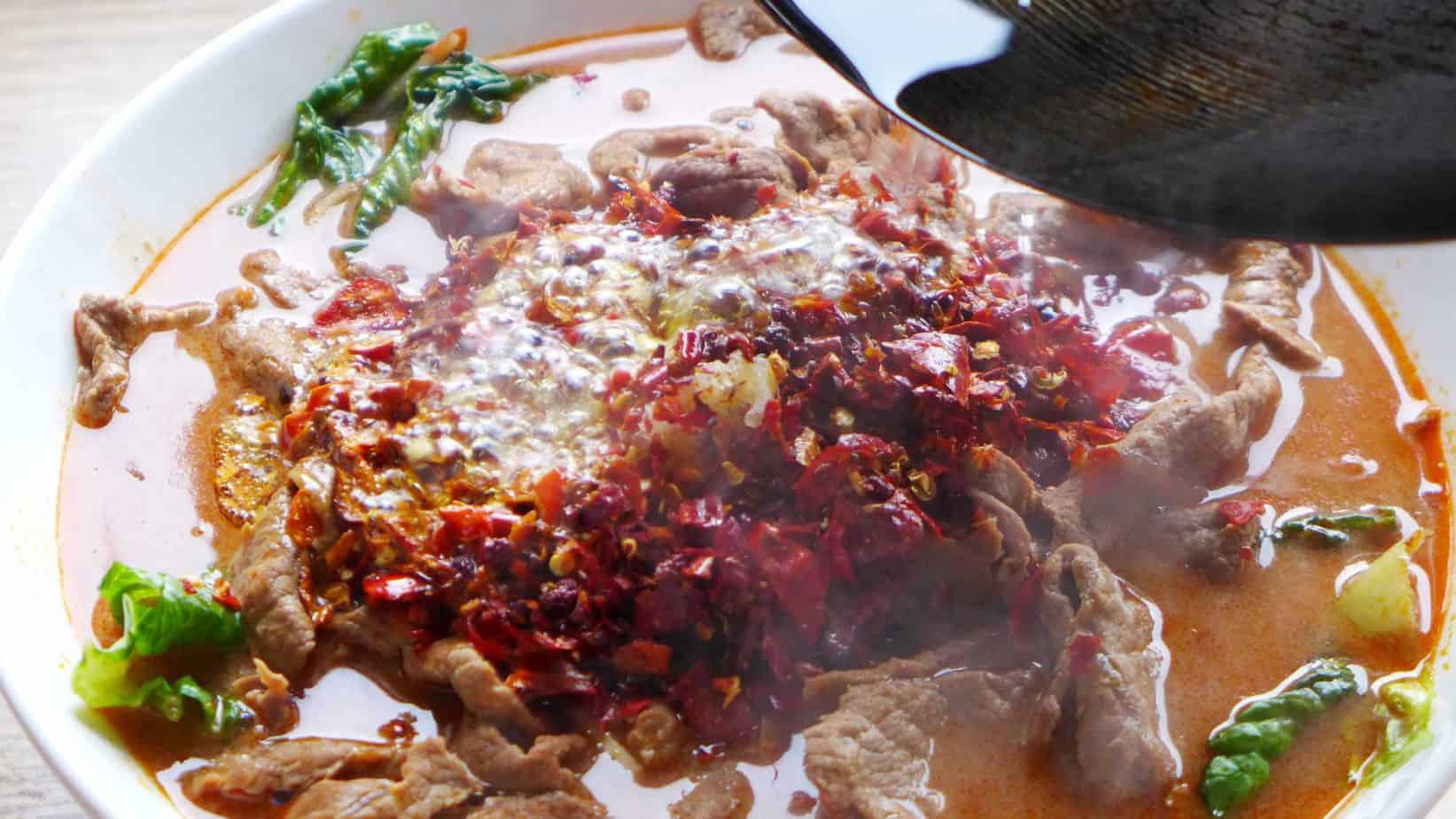
Other Sichuan recipes
Looking for more spicy Sichuan dishes? Check out these classic recipes:
📋Recipe
Love this recipe? Please leave a 5-star 🌟🌟🌟🌟🌟 rating in the recipe card below & if you REALLY like it, consider leaving a comment as well!

Sichuan boiled beef (Shui Zhu Niu Rou, 水煮牛肉)
Ingredients
For the beef
- 300 g beef - 10oz, see note 1
- 1 pinch salt
- 1 teaspoon Shaoxing rice wine
- 1 teaspoon dark soy sauce - or regular soy sauce
- 1 egg
- 1 tablespoon cornstarch
- 2 tablespoon water
- 1 teaspoon sesame oil
For the spicy topping
- 1 teaspoon cooking oil
- 1 handful dried chillies, seeds removed - see note 2
- 1 tablespoon Sichuan peppercorns - see note 3
For the vegetables
- half Romaine lettuce, coarsely chopped
- 1 handful bean sprouts
For the broth
- 2 tablespoon cooking oil
- 6 slices ginger
- 3 cloves garlic, sliced
- 2 tablespoon Sichuan chilli bean paste - see note 4
- 1 teaspoon chilli powder - or to taste
- 500 ml unsalted stock or water - 2 cups
For the garnish
- 2 tablespoon cooking oil
- 1 tablespoon minced garlic
- coriander, chopped
Instructions
Marinate the beef
- Cut the beef, against the grain, into thin slices (about 2mm).
- Put them into a mixing bowl. Add salt, Shaoxing rice wine, dark soy sauce, egg, cornstarch and water.
- Rub and mix with hands until the liquid is absorbed.
- Add sesame oil then stir well.
Fry the spicy topping
- Add oil, dried chillies and Sichuan peppercorns in a wok.
- Fry over low heat until fragrant (do not burn).
- Transfer onto a chopping board. Chop small then set aside.
Fry the vegetables
- Put romaine lettuce and bean sprouts in the same wok.
- Fry with the remaining oil over medium heat until they lightly wilt.
- Transfer to the serving bowl and set aside.
Prepare the broth
- Pour oil into the wok. Add ginger, garlic, Sichuan chilli bean paste and chilli powder. Fry over low heat until fragrant.
- Pour in stock/water. Cook over high heat until it starts boiling.
Cook the beef
- Turn the heat to medium. Add marinated beef, one piece at a time.
- Simmer until fully cooked (no pinkness on the surface).
- Pour the beef and stock onto the vegetables.
Sizzle & garnish
- Place minced garlic & chopped spicy topping over the beef.
- Heat up the oil in the wok (cleaned and dried) until smoking. Pour it over the garlic & spices.
- Garnish with coriander and serve immediately with plain rice.
Video
NOTES
- Facing heaven chilli (Chao Tian Jiao/朝天椒) which has a quite high heat level.
- Lantern chilli (Deng Long Jiao/灯笼椒) which is mild in heat but very fragrant.
NUTRITION
NUTRITION DISCLOSURE: Nutritional information on this website is provided as a courtesy to readers. It should be considered estimates. Please use your own brand nutritional values or your preferred nutrition calculator to double check against our estimates.


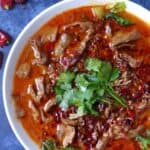
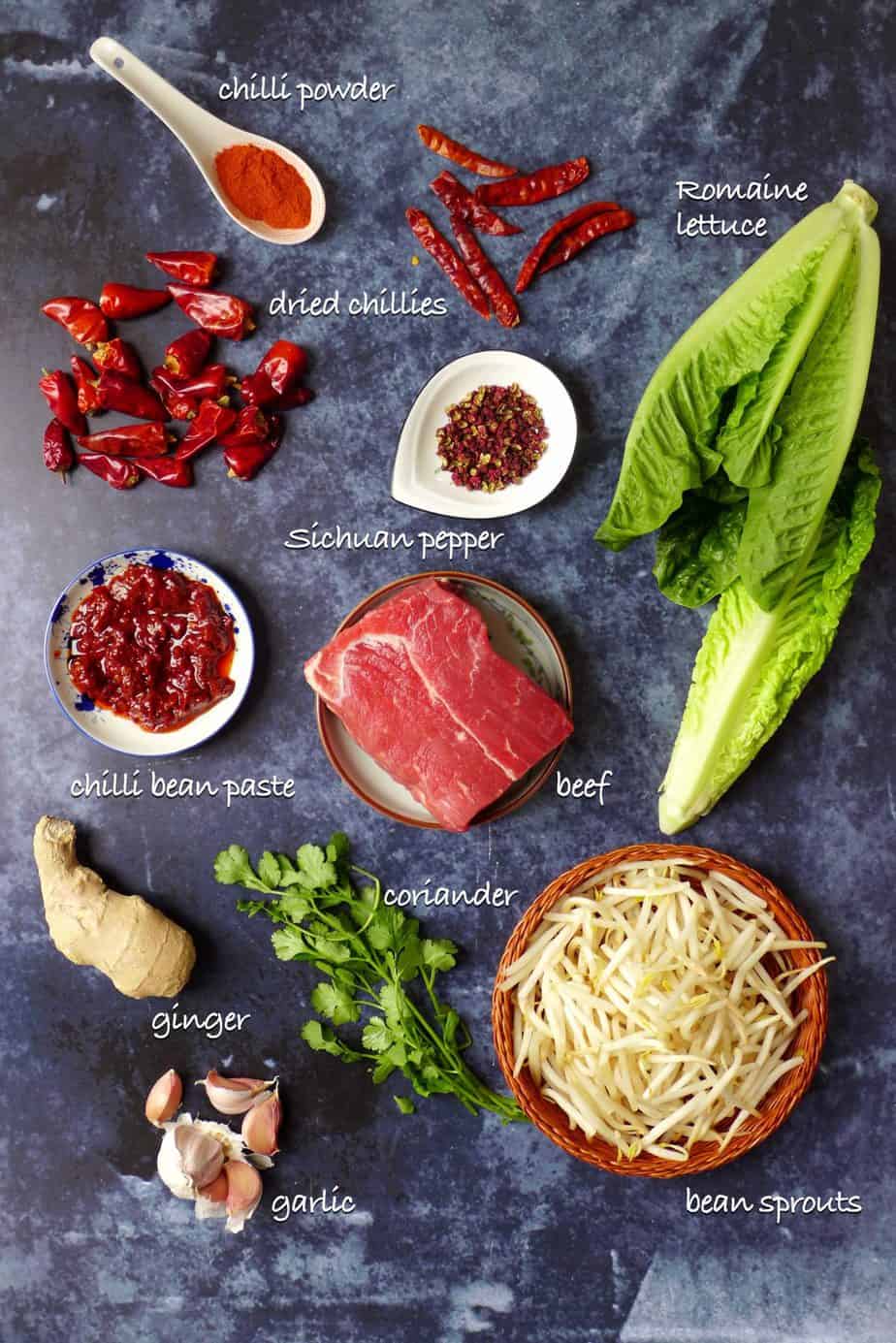
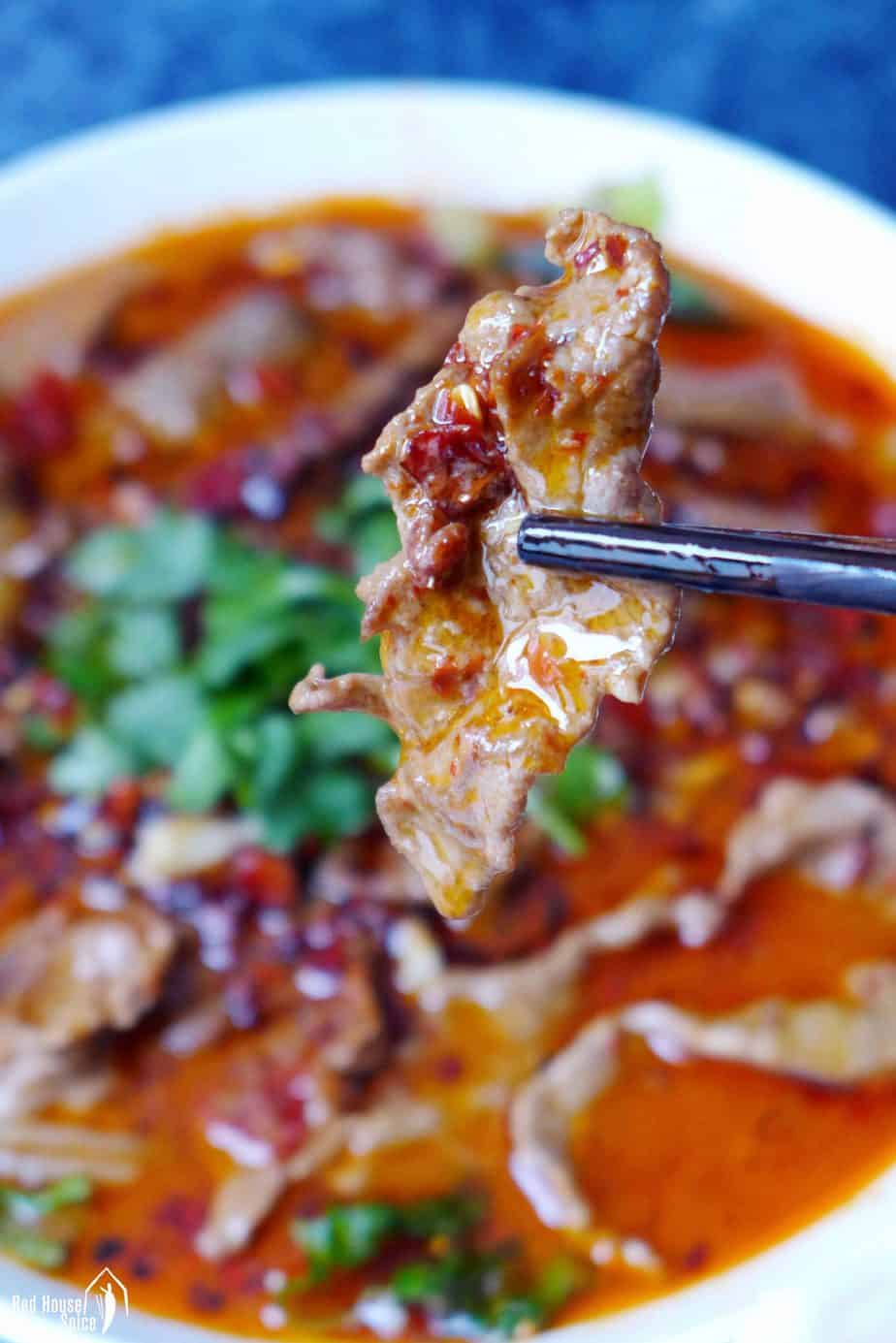
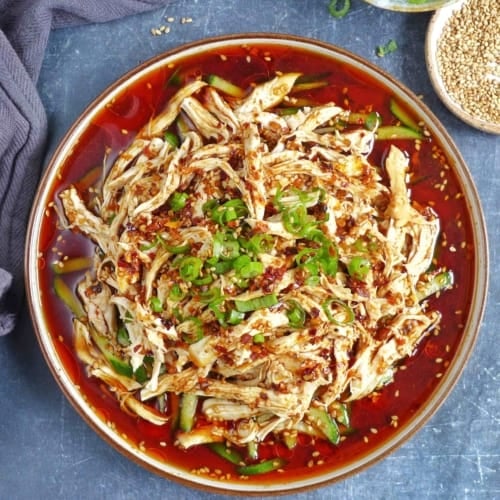
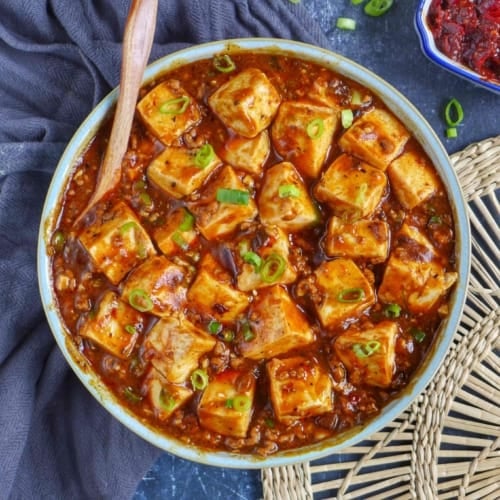
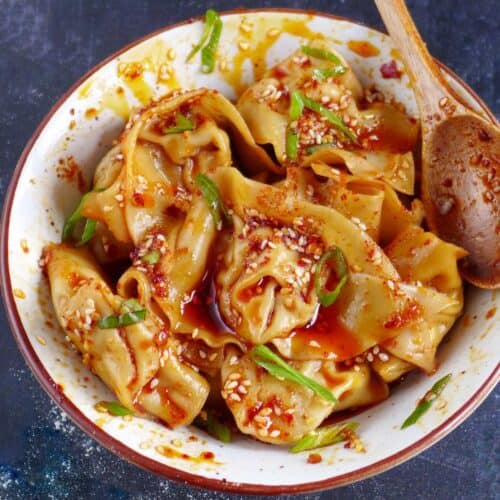
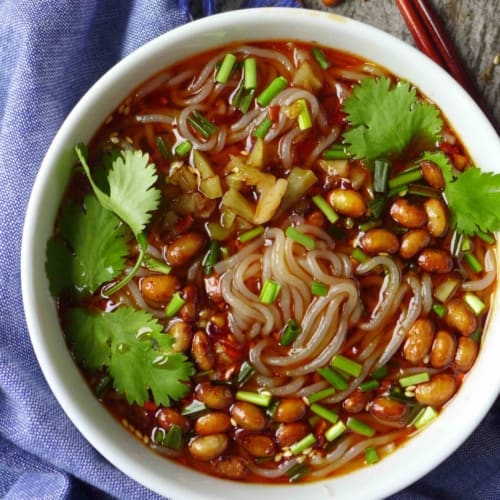
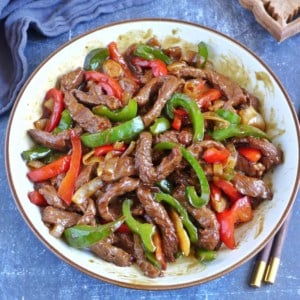
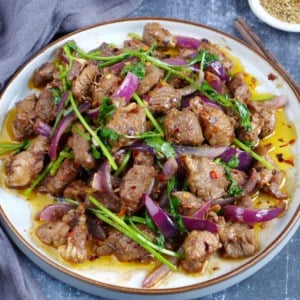
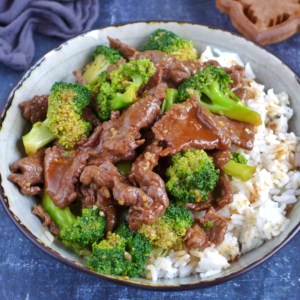
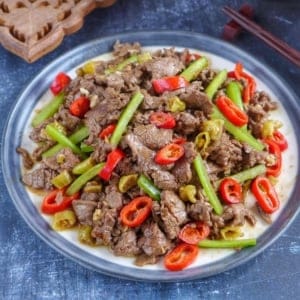
How do you use your mala hotpot base to do this recipe? You mentioned it could be used
Hi Garry! You can replace Sichuan chilli bean paste in the recipe with the Mala hot pot soup base.
Is it supposed to be SUPER hot? We didn’t put the chilli powder and at the end it was so hot that we didn’t even put the fried chillies on the top. Or is the paste I am using maybe too hot, maybe do you have a brand recommendation?
The authentic version of this dish is supposed to be quite hot but the heat doesn’t really come from Sichuan chilli bean paste. As I explained in the post, the best-known variety of this sauce is Pixian Douban (郫县豆瓣, Pixian broad bean paste). If you can’t handle too much heat, use chilli powder and dried chillies that have a mild taste. Hope this helps!
Love some sichuan food and this dish is great at my local restaurant.
I’m curious though because when eating some dishes (Like Laziji) you’re not supposed to eat the dried chilis.
Do people generally eat the all the “soup” in this dish or mostly search out the meat, veggies etc and eat with rice.
The soup always seem way more spicy than other dishes that are supposed to have similar heat.
You’re right Mattias. When eating Laziji, you’re not supposed to eat the dried chilli or Sichuan pepper. The same applies to this dish. People would just pick out the meat and vegetables to eat. The spices and soup are not for consumption.
Wonderfull, a bit too spicy so i added only half the chilis.
Super tasty
Glad you’ve enjoyed Henk!
What do I served this with?
Hi Adlin! This dish is usually served with plain steamed rice, along with other savoury dishes. Pairing it with a few vegetable dishes would be good.
Hi Wei! This is one of my favourite dishes at my favourite Sichuan restaurant, and I’d love to try your recipe. I was just wondering if the ingredients really match the number of servings – e.g. 500ml of stock seems very little for three servings. Or am I missing something? Thank you!
500ml of stock is what you need for the quantity of other ingredients listed in my recipe. If you think the portion is too small for you (the size of a serving can be subjective), increase the volume proportionally for all the ingredients. Hope this helps!
Was an amazing recipe. Never heard of pouring the searing oil over everything in the end but that really lifts everything up. One thing though: My Sichuan Peppers seem to follow all the points you mention however they end up being VERY crunchy to the point of almost having the texture of having some sand in your dish. Is that normal? First time using them.
Thank you Mark for trying out my recipe! It sounds like your Sichuan pepper had been overcooked. Another thing is that the dried chillies and Sichuan pepper are for adding flavours to the dish. Usually they’re not supposed to be eaten (you may already know this. Just in case).
Recipe looks very good to me and am sure it will be yummy.
Thank you Mathew! It’s certainly a very yummy dish.